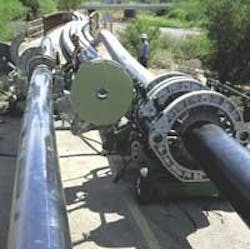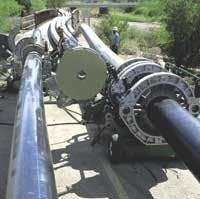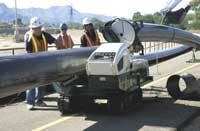Tucson Employs HDPE to Halt Contamination in Record Time
The city of Tucson, AZ, was recently disrupted by a large sewer bypass operation. Over 20 miles of high-density polyethylene (HDPE) pipe was fused together in just four and a half weeks to bypass a ruptured sewer line. The 42-inch concrete mainline, which was built about 40 years ago, burst in several places and the resulting deluge caused three massive sinkholes in the downtown area. The repair alone is estimated at over $15 million, not including property damage.
The major concern for the Arizona Department of Environmental Quality was the 5-7 million gallons of untreated sewage that was released per day into the Santa Cruz River during the first seven days of the spill. The river was temporarily dry at the time. The need to minimize the environmental impact of the spill, and to complete the bypass before water returned to the river, was the driving force that spawned the massive undertaking.
The bypass consisted of four parallel 20 inch and 24 inch HDPE lines approximately five miles each. The bypass lines were designed to handle the flow of sewage for four to six months while the mainline was repaired.
"Due to the aging infrastructure in the U.S., there is a lot of opportunity for bypass jobs because mainlines are beginning to fail at an increased rate," said Ismael Diaz, Engineer and Project Manager for Rain For Rent, the general contractor for the project. "We started slowly using HDPE in the last couple of years for bypass operations and now with this job, we have jumped in with both feet."
Rain For Rent is based in Bakersfield, CA, with offices across North America. The company began as an oilfield supply company in 1934 and has evolved into a liquid and solids handling business that also handles pumps, liquid storage tanks, pipe, roll off boxes and separation and filtration equipment.
The city of Tucson has used HDPE on two large-scale water projects in the past. Sixty thousand feet of 16, 24, 42, 48 and 54 inch HDPE were used to bring water from several wells to a reservoir.
"We hope that the success HDPE has had on the bypass job will open the door for more polyethylene use in the city," said Denise Ernst, SW Regional HDPE Manager of Maskell-Robbins (MR), the pipe supplier and subcontractor orchestrating the fusion process. "Unless it is a real high temperature or high pressure application, it is the best piping material made."
Along with the time restraints of the Tucson bypass project, a challenging aspect was the limited amount of space the pipeline would be able to use. An asphalt bike path that runs along the river was used as the right-of-way for the pipeline. The four pipelines traveled across four pedestrian bridges and underneath four roads in tunnels built for bike travel. The crews were also under strict stipulations not to damage the plant life on both sides of the path.
"HDPE is the only pipe material that could have been used for this operation," said Adam Rivas, fusion technician of MR. "It is flexible enough to handle the curves of the path and follow the contour of the land. It is also the only material of this size that could been joined together in this short amount of time."
HDPE is heat fused together and the resulting joint is stronger than the pipe itself in both tensile strength and pressure conditions. Unless there is third party damage, there is no chance for the pipe to fail and further contaminate the area. MR supplied a total of 10 fusion machines from MCElroy Manufacturing to fuse the pipe together.
"McElroy builds the Cadillac of fusion equipment," said Ernst. "I am very pleased with the way all of the fusion equipment performed on this fast-track job because any failure of equipment could have postponed the entire operation."
McElroy's TracStar 500 was of particular importance on the location. The TracStar 500 is a mobile fusion machine mounted on a track system with an onboard generator.
"Without the TracStar machines I don't see how this job could have stayed on schedule," said Rivas. "It has almost double the gauge pressure of a conventional machine and the added pressure coupled with the power of the tracks gives you the force needed to overcome drag and achieve proper fusion pressure."


